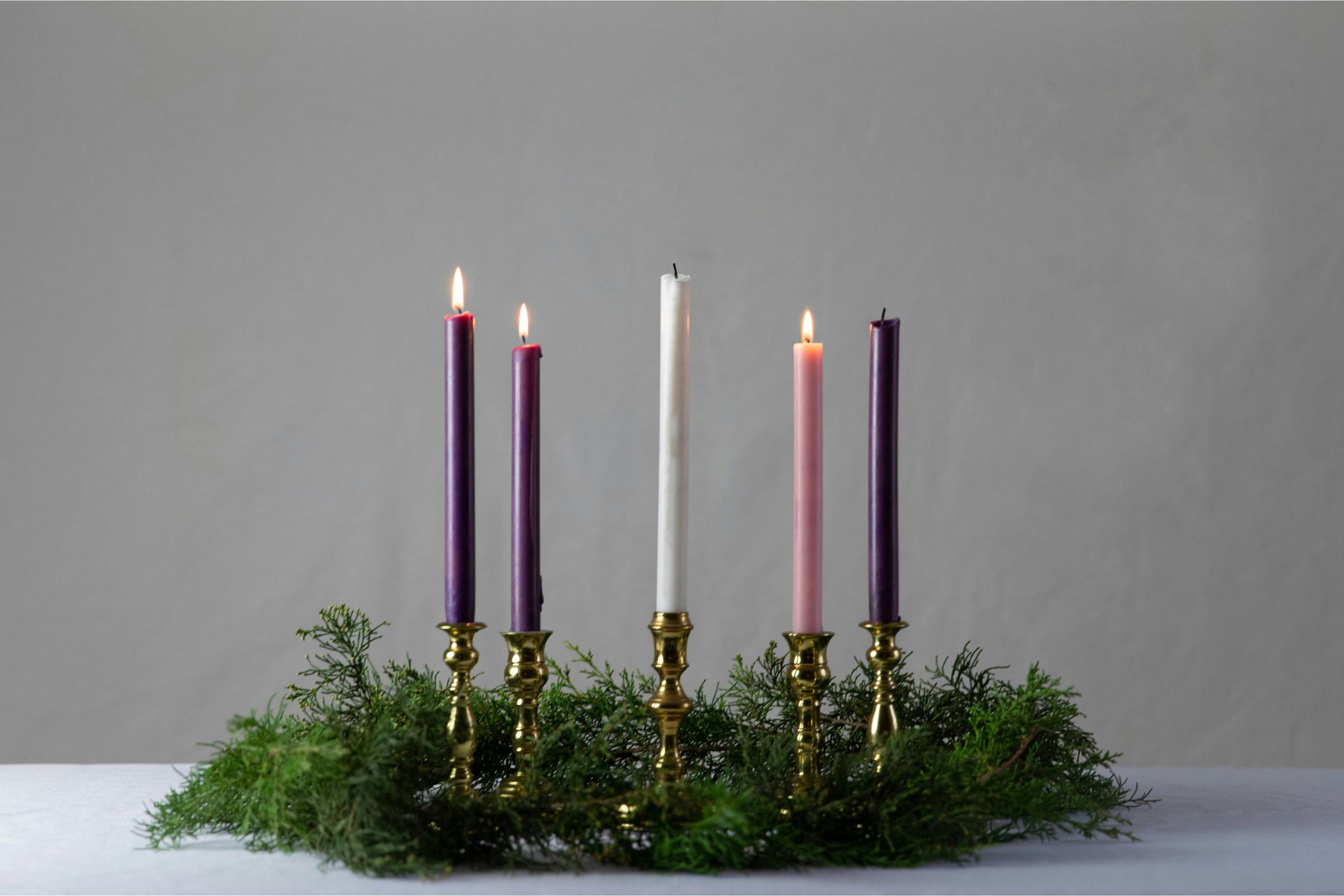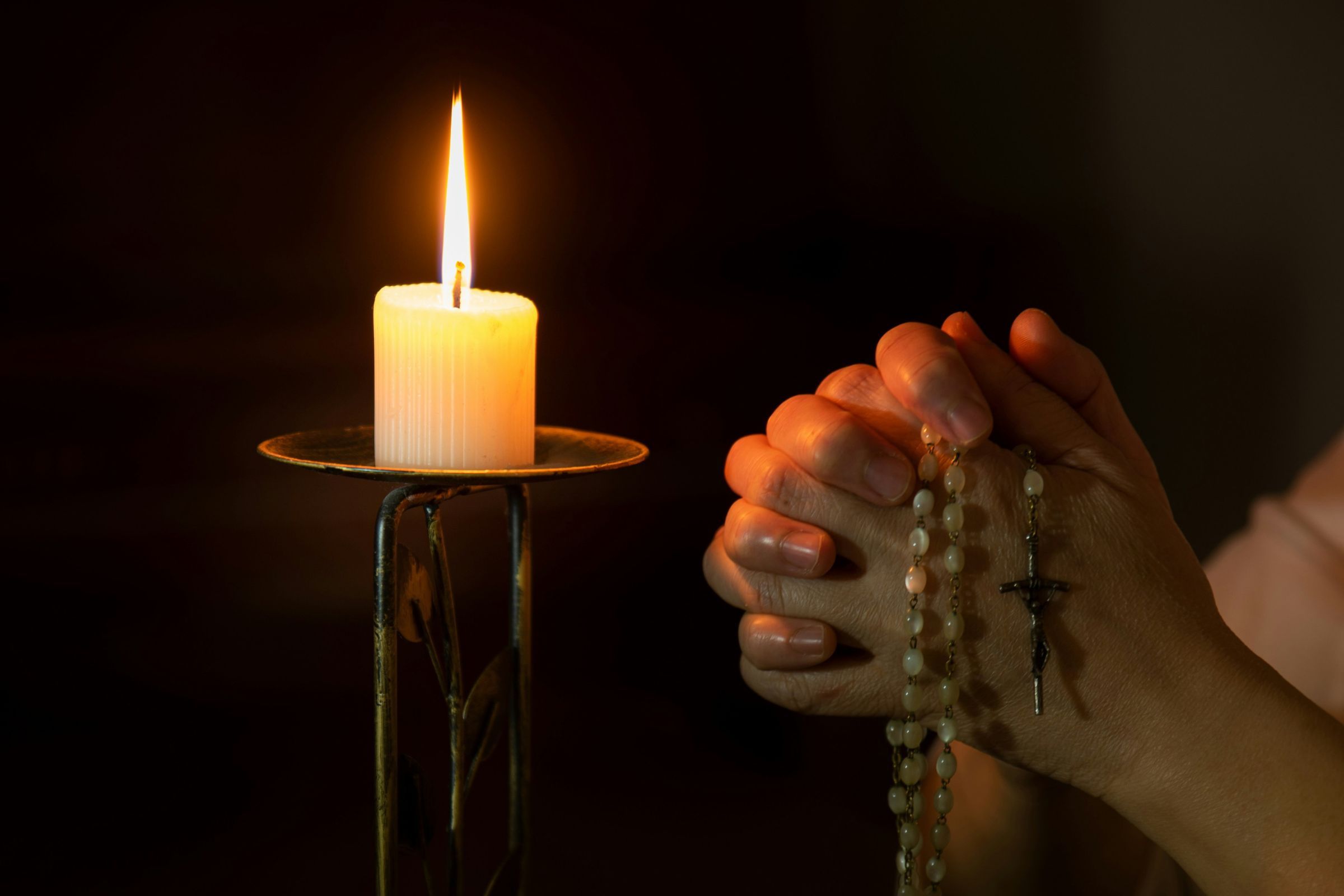

Many people’s concept of Advent is limited to the number of days remaining until Christmas Day. But there’s so much more to this sacred season than merely passing the time until December 25!
In this post, we’ll explore what Advent is, how it became a liturgical season, and different ways you can pray that will enrich your Advent observance as well as your Christmas celebration.
Advent is the season that begins a new liturgical year in the Church, starting four Sundays before Christmas and ending on Christmas Eve. The Advent season is a time of waiting, anticipation, and preparation for celebrating Christ’s birth.
The Church observes Advent with special liturgies. Each Sunday, a candle is lit on the Advent wreath (the fifth or center candle, also known as the Christ candle, is lit on Christmas Eve). The Mass readings include Old Testament prophecies and other Scripture passages pointing to the coming of Christ. The liturgical color is purple, representing the penitential spirit of the season. An exception is the third Sunday of Advent, Gaudate Sunday, when the Advent candle and the priests’ vestments are colored rose to represent joy.

Advent has traditionally been observed as a penitential season, similar to Lent, to better prepare to celebrate our Savior’s birth. However, since Canon Law doesn’t technically define Advent as such, specific penitential practices aren’t binding upon Catholics like they are during Lent. But, as in every season of the Church year, the spiritual life is greatly aided through prayer, penance, and acts of charity, making these fitting ways to observe this sacred season of Advent.
Below, we’ll explore different ways you can observe Advent. But first, let’s take a quick look at the historical origins of this liturgical season.
While the exact origins of Advent are unknown, its earliest records date back to the 4th century. In France, new Christians were often baptized on the Feast of Epiphany, January 6. Before receiving this sacrament, they would go through a season of preparation involving prayer, penance, and fasting. This “St. Martin’s Lent” would last from the Feast of St. Martin of Tours on November 14 until Epiphany, or 40 days.
In 6th-century Rome, this period became a preparation to celebrate Christ’s coming. The Latin word for “coming” is adventus, which is how the Advent season got its name. However, this was in anticipation of Christ’s second coming at the end of time, not his first coming at his Nativity (this connection wasn’t made until the Middle Ages in Europe). By the late Middle Ages, this period had been shortened to four weeks in the Latin Church, making way for the 4-week liturgical season of Advent that we know today.

Traditional penitential practices of fasting and prayer seem far removed from today’s culture of Christmas commercialism and holiday cheer. But, Advent isn’t about missing out on all the festivities! Rather, it’s about focusing on preparing your heart to welcome the newborn King—a preparation that will actually enhance your Christmas celebration.
Read on for ways to observe Advent through prayer and penance that can fit into any schedule or lifestyle.
Prayer is essential to spiritual growth in any season, making it a fitting Advent practice and Christmas preparation. Here are 4 ways to pray during this sacred season:
1. Go to Mass. Observe each week of Advent at Sunday Mass, and try to attend daily Mass whenever your schedule and circumstances allow. When you’re not able to attend in person, you can pray with the CatholicTV Mass.
2. Visit an adoration chapel. Stop by for a few minutes of prayer as you go about your errands, or find a time on your calendar to make a Holy Hour to spend with Our Lord. If you’re homebound, you can pray with Eucharistic adoration on YouTube.
3. Pray the Rosary and other Marian prayers. One of these prayers, the Angelus, is a beautiful and brief prayer that meditates on the Incarnation and Mary’s “yes” to God’s plan of salvation.
4. Read the daily Scripture readings for Mass. To engage more deeply with Scripture, try praying with lectio divina or visio divina (find a visio divina meditation on the Annunciation here or on YouTube—it takes less than 20 minutes to pray!).

The focus of penance is not to be miserable (as is the popular misconception), but to identify areas of sin in your life and take intentional steps to overcome them. However, penance isn’t a DIY self-improvement project. Rather, our free will cooperates with God’s grace, which enables us to grow in holiness. By seeking to identify and eliminate sin in your life, you are “making room” for the newborn King at the “inn” of your heart.
Here are some ways to practice penance during Advent:
1. Go to Confession. The Sacrament of Penance and Reconciliation is where, through God’s grace, we receive not only forgiveness for sins but also the strength to resist temptation. Outside of the Mass, this is one of the best ways to prepare for Christmas!
2. Consider fasting or abstinence in some form. Is there something you could give up until Christmas? Perhaps you can abstain from a holiday treat or forego your regular coffee run (better still, donate the money you save to charity!). If your health and circumstances allow, the more traditional form of fasting from specific meals or abstaining from meat can also be fruitful practices for Advent.
3. Do acts of charity. Thankfully, this practice is more culturally popular this time of year, so it’s easy to find opportunities. Besides donating to your favorite Catholic ministries and other charities, you can also volunteer your time at a local charity or donate goods to a food pantry or coat drive.
4. Seek reconciliation in your relationships. If there is anyone you have wronged, try to make it right. Pay them a visit to apologize, or pick up the phone or write a letter to do so. If anyone has wronged you, make a conscious decision to forgive them, even if they don’t ask for it! Pray for God’s grace to help you take the first steps toward reconciliation, and trust that, even though the relationships may not be fully restored, you’ve done what you could to be reconciled to your brother or sister (see Matthew 5:23–24). This is a difficult but powerful way to prepare to offer ourselves to the newborn King at Christmas!
Now that you know more about what Advent is, how it began, and how you can observe this sacred season, you’re equipped to make the most of this special time of year. Prayerfully consider how Our Lord is inviting you to encounter him this Advent, and prepare for an enriching spiritual journey—and quite possibly one of the best Christmases yet.